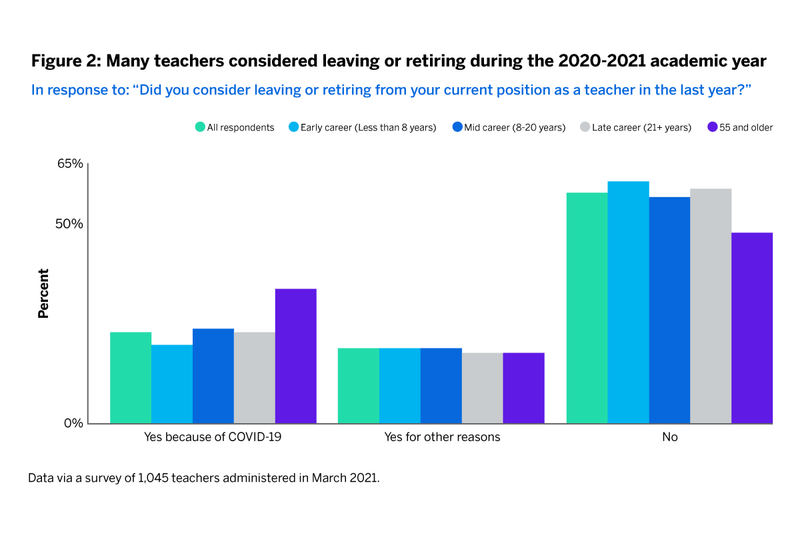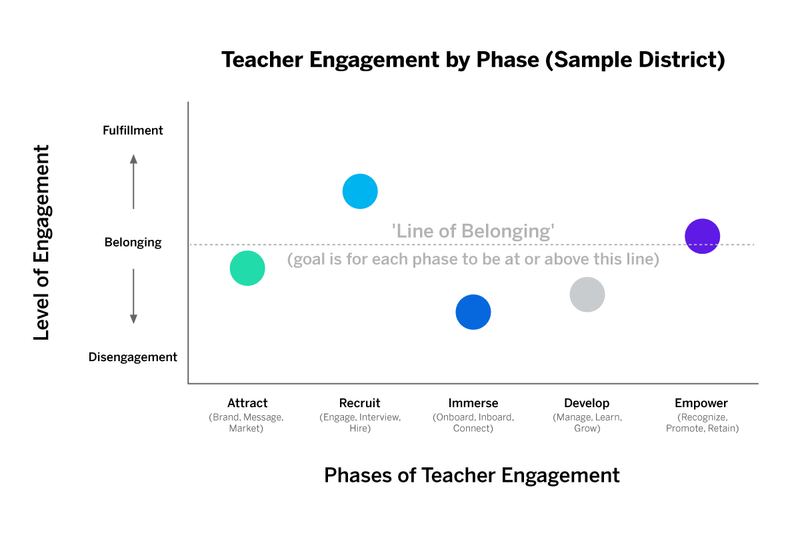Good teachers who stay deliver the best outcomes for students, fellow teachers, school leaders and the wider community. Yet teacher retention is one of the most challenging issues facing educational establishments today, and the COVID-19 pandemic has added another layer of complexity to it. And teacher retention is not always the school’s problem: changes in school funding, external economic factors such as the cost of living, and fluctuations in the job market all have knock-on effects that can influence teachers’ decisions to stay in or leave the profession.
Gauge your teachers’ satisfaction with a free survey template
What is teacher retention?
In terms of definition, teacher retention is no different from the retention of any other employee: the employee chooses to stay with their current employer rather than actively seeking another job, and the employer does all it can to make sure the employee doesn’t leave.
By contrast, employee turnover is where employees leave their jobs, for many reasons, and the employer cannot persuade them to stay.
Every company, sector, and industry, including education, has its own retention rate. This is calculated by dividing the number of employees remaining at the end of a period (like an academic year, for education) by the number of employees present at the beginning of that period, and multiplying by 100 to get the percentage:

In the US, for example, the National Center for Education Statistics (NCES) found that every year, 8% of teachers leave their profession early, and another 8% move to a different school, giving a total turnover rate of 16%.
But this 16% is just a snapshot of the average across school districts. Traditional and charter public schools, particularly those in dense cities, may have a turnover rate of more than 30%, whereas schools in wealthy, suburban areas may have a rate as low as 5%.
Why is teacher retention important?
When teachers stay in their schools, the whole educational system benefits and improves, by:
Saving money
It costs far more to recruit and train novice teachers than it does to retain experienced ones. The cost for every US teacher who leaves can range from $9000 in rural areas to $21,000 in cities.
Increasing investment
Schools that are not having to fork out the $9000 – $21,000 on teacher recruitment costs can use that money instead to invest in facilities, technology, and resources for the benefit of their students.
Benefiting the less privileged
Teacher attrition in schools that serve lower-income communities can be 50% higher than average, and it is well known that high teacher turnover adversely affects children’s education, hitting the poorest ones, and ones with special education needs, the hardest.
Enabling policy development
High teacher turnover is destabilising for everyone in the education system, and continual staffing flux makes change and improvement policies difficult to deliver.
Keeping valuable knowledge
Experienced teachers know their school and their students inside out. Their input is vital when it comes to identifying needs and developing solutions. When they leave, their experience is lost and overall teacher quality may suffer.
How does teacher turnover affect student achievement?
We all remember a favourite teacher at school – they may have been particularly kind, strict but fair, inspirational, helped us understand something we struggled with or acted as a mentor or role model. For many children, a favourite teacher is irreplaceable, and if they leave, it can be particularly upsetting. Students missing an influential teacher may disengage, participate less, and achieve lower grades.
When permanent teachers leave, substitute teachers are brought in. Substitutes may be less qualified and experienced, and may not know what makes their students excited and engaged about learning, which may lead to disruption and poor scholastic performance. And it’s hard for the new teacher to step into the previous one’s shoes, particularly midway through the academic year.
Why do teachers leave?
The academic year 2020-2021 with the COVID-19 pandemic was unprecedented. In March 2021, 42% of teachers said that they had considered leaving or retiring from teaching, with just over half of those giving COVID-19 as the reason:

While COVID-19 is a significant, ‘black swan’ event that has affected teacher retention, there were issues that affected it before 2020
Accountability and ‘teaching to the test’ pressures
In the US, the ambitious but controversial 2002 No Child Left Behind (NCLB) Act had noble intentions – to provide more educational opportunities for disadvantaged students, focusing on four key groups:
- Students in poverty
- Students of colour
- Students receiving special education
- Students who spoke and understood little or no English
The NCLB held public schools accountable for how children learned and achieved, with annual testing, reporting, and improvement targets, and with penalties for schools that didn’t demonstrate improvement. Public school teachers were put under huge pressure to deliver so that schools were not penalised. Across many school districts, this pressure was too much for many teachers and education leaders found that their teacher turnover increased.
The NCLB was replaced in 2015 by the less rigid (and less stress-inducing) Every Student Succeeds Act (ESSA) that aimed to help the teaching profession focus more on actual teaching and less on test scores.
Throughout the world, government policy continually changes in the pursuit of excellence in education systems, often resulting in added pressures on teachers. Where education leaders fail to listen to their teachers’ feedback on new initiatives, they risk missing factors that influence teacher attrition.
Leadership support
Teachers who strongly disagreed that their education leaders were supportive were more than twice as likely to leave than teachers who agreed that leadership supported them.
Disillusionment with a teaching career
When teachers feel they have little influence on school decision-making and can go no further in their careers at a particular school, they consider leaving.
Challenging working conditions
Limited resources, low-quality buildings, large class sizes, behavioural challenges and lack of education leaders’ and team support can all make a teacher feel that they must leave their school.
Feeling undervalued
Undervaluing teachers appears to be a global phenomenon, according to one study. In the USA, only 34% of teachers believe that the teaching profession is valued, whereas most teachers in Singapore, Abu Dhabi, and Finland (which receive 10 applications for every teacher training position) feel that society values their profession.
How to retain your best teachers
There are three factors that influence a teacher’s decision to stay at a school or leave:
Administrative support
There is a huge amount of administrative work associated with teaching: photocopying activities, preparing lesson plans, grading work, writing reports, and much more. Teachers who have little or no leadership support to do these tasks, as well as teaching, are more likely to leave their jobs. The best way to support teachers administratively is to give them plenty of opportunities to express their opinions and voice any concerns. You can then take early action before administration becomes a burden that loses you a member of staff.
Collaboration opportunities
Teachers work better when they collaborate, and collaboration also improves retention rates. By providing collaborative opportunities from the very start of each school year and throughout, you can build a happy working environment built on trust and goodwill. This will not only improve classroom teaching outcomes for student achievement, but it will also be an organic form of professional development for all staff.
Teacher engagement
There are five phases of teacher engagement, and at its core should be belonging. When teachers feel they belong at a school, they are well on the way to fulfilment, which is the gold standard for teacher workforce engagement. Anything less than a feeling of belonging counts as disengagement, and you risk teacher turnover:
1. Attract
In order to attract the best new teachers fresh from their teacher preparation programs and then work to keep them, the school needs to have its branding, messaging, and marketing right to kick off that sense of belonging. Potential teachers need to be able to see that your school’s mission aligns with their own values, their subject expertise is fair and equitable, and that they feel they’ll belong.
2. Recruit
No matter how slick and attractive your unique value proposition, school brand, and marketing communications appear, a negative recruitment experience can put off the best teachers, leaving them running to competitors in other school districts. Work hard on making your recruitment process the most welcoming, effective, and equitable you can be so that potential recruits will feel right at home the moment they step through your doors.
3. Immerse
Your onboarding experience is critical to making your newly hired teachers feel they belong. A warm welcome, everything that they need to be prepared in advance, expectations clearly outlined, and any mentorship programs in place will soon help your newly-recruited teachers settle in and get started.
4. Develop
No teacher wants to stay in a school that doesn’t develop them. Teachers thrive in a collaborative environment that encourages individual working styles, continual learning opportunities, and professional development pathways. When teachers can be themselves at work, bringing their unique contributions into the classroom all the while being supported by the leadership team, they are likely to be fulfilled and stay.
5. Empower
Teachers are no different from employees in other professions in that they appreciate a little appreciation. It’s true that a culture of appreciation directly affects retention – positively. It’s important to celebrate teaching staff members who embody the spirit of the school, by implementing clear routes to leadership and ensuring every teacher’s voice is heard in the decision-making process.
The importance of surveys in teacher retention
“I didn’t know you were thinking of leaving!” is the mantra of the establishment – educational or otherwise – that doesn’t listen to its employees. Education leaders need to be able to gauge their staff’s sentiment at any time and address issues as they crop up before they become a problem and lead to disengagement and teacher attrition.
This is where surveys are so valuable, and the resulting data analytics can give real-time snapshots of what is going on in a school. Surveys are especially important to ‘keep a finger on the pulse’ when teaching is virtual, as it was during pandemic lockdowns.
There are various types of surveys that you can use to listen to your teachers:
When you invest in survey software such as Qualtrics AXM you will be able to combine all your student, teacher, family, and community data on one centralised and controlled survey collection platform. Teacher engagement, professional development plans, assessments, and surveys all sit within the teacher section, yet feed into a holistic analysis of all four data segments. The dashboard-based analytics are now so sophisticated you will be able to see what factors impact others – including teacher retention – and take action immediately to keep your best educators.
Start collecting teacher feedback today with our free survey template
